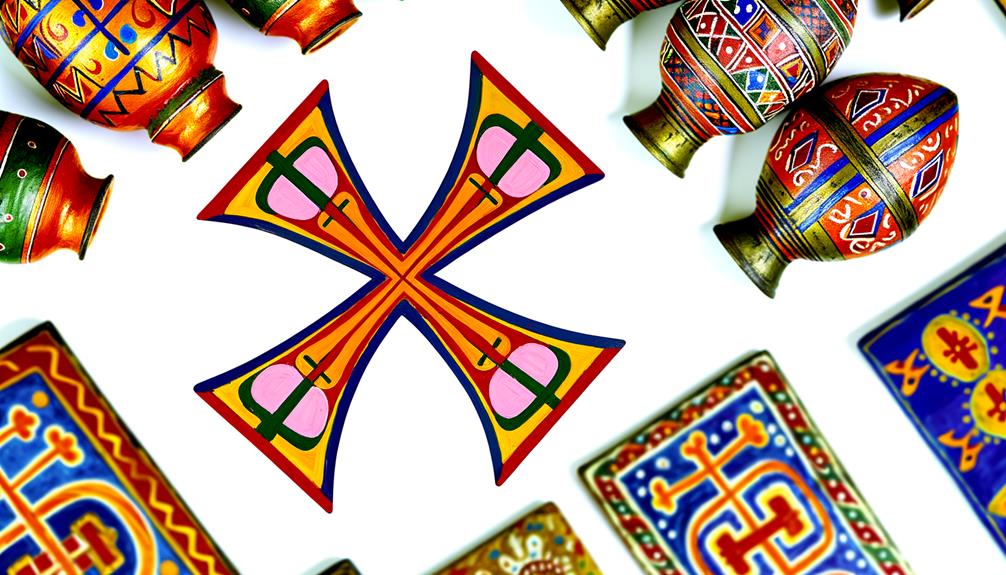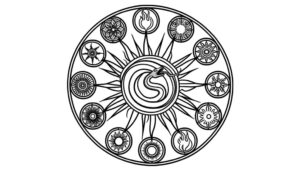What Is the Meaning of the Swastik Across Cultures?
The swastik symbol, originating in the Indus Valley Civilization around 2500 BCE, is deeply embedded in Hinduism, Buddhism, and Jainism, where it signifies prosperity, auspiciousness, and spirituality. Its symmetrical design has facilitated its widespread recognition across diverse ancient cultures, reflecting various meanings such as eternity in China and continuous movement in Greece.
Despite its misuse by the Nazi regime, which led to global stigmatization, efforts are ongoing to restore its positive connotations. Legal restrictions in several countries aim to prevent its association with hate speech.
Understanding these aspects reveals the symbol's complex cultural significance and universal appeal.

Key Takeaways
- The swastik symbolizes prosperity, auspiciousness, and eternity in Hinduism, Buddhism, and Jainism.
- Originating around 2500 BCE in the Indus Valley Civilization, it signifies ancient cultural importance.
- In Hinduism, it represents order, harmony, and attracts positive energy during rituals.
- Different cultures view it as a symbol of life, power, continuous movement, and eternity.
- Its misuse by the Nazi regime led to stigmatization and legal restrictions in various countries.
Historical Origins
The swastik symbol, with its deep antiquity, first emerged in the archaeological record of the Indus Valley Civilization around 2500 BCE, signifying its ancient and widespread cultural significance. This geometric emblem, characterized by its cross with bent arms, appeared on pottery, seals, and other artifacts.
Its presence in the Indus Valley suggests a well-established motif used in various contexts, possibly extending beyond mere decorative purposes. The swastik's symmetrical design made it easily reproducible, aiding its dissemination across different civilizations.
Subsequent archaeological findings have traced the symbol's spread to various cultures, including those in Mesopotamia, Europe, and China. This widespread occurrence underscores the symbol's importance and the interconnectedness of ancient civilizations in sharing symbolic and artistic traditions.
Cultural Significance

The Swastik symbol, bearing profound ancient symbolism, has been revered in various cultures such as Hinduism, Buddhism, and Jainism, where it represents concepts like prosperity, auspiciousness, and eternity.
In modern times, however, the symbol's interpretation has been deeply affected by its appropriation and misuse during the 20th century, particularly by the Nazi regime.
This duality of meaning underscores the complexity of the Swastik's cultural significance across different historical and social contexts.
Ancient Symbolism Across Cultures
Recognized for its intricate design and profound implications, the swastik symbol has permeated various ancient cultures, each attributing unique cultural and spiritual significance to its form.
- India: In Hinduism, the swastik represents prosperity, good fortune, and the cycle of life.
- China: The symbol signifies eternity and is commonly seen in Buddhist texts and temples.
- Greece: Known as the gammadion, it symbolized continuous movement and the cycle of life and death.
- Native American Cultures: It often depicted the sun, representing life, power, and continuity.
These diverse interpretations underscore the symbol's universal appeal and its deep-rooted significance across civilizations. Each culture's unique context imbues the swastik with layers of meaning, reflecting their historical and spiritual landscapes.
Modern Interpretations and Misuse
In contemporary times, the swastik symbol has become a subject of controversy and misunderstanding, largely due to its appropriation by the Nazi regime during World War II.
Originally an ancient symbol of auspiciousness, the swastik was co-opted and transformed into an emblem of hate and genocide, altering its perception in the Western world.
This has led to widespread stigmatization and a disconnect from its historical and cultural roots.
In contrast, in many Eastern cultures, the swastik continues to be revered as a sacred and positive symbol.
The dual interpretations demonstrate the complex layers of cultural significance and the impact of historical misuse.
Understanding these nuances is essential for fostering a more informed and respectful global perspective.
Symbolism in Hinduism
In Hinduism, the Swastik symbol holds profound significance, often associated with sacred geometry, which represents order and harmony in the cosmos.
It is also considered a powerful emblem of auspiciousness and prosperity, frequently used in rituals, ceremonies, and architectural designs to invoke positive energies.
Sacred Geometry Significance
The Swastik symbol holds profound sacred geometry significance in Hinduism, representing an intersection of cosmic principles and auspiciousness. Its design, featuring a cross with arms bent at right angles, conveys deep symbolic meaning rooted in the universe's structure.
The geometry of the Swastik encapsulates:
- Balance and Harmony: The symmetrical form symbolizes equilibrium between opposing forces.
- Directional Unity: The four arms point to the cardinal directions, indicating a holistic perspective.
- Cyclical Nature: The continuous flow of the lines suggests the eternal cycle of life, death, and rebirth.
- Spiritual Center: The central cross represents the point of origin and the divine nucleus.
Understanding these geometric principles provides insight into Hindu cosmology and spiritual beliefs, emphasizing the Swastik's enduring significance.
Auspiciousness and Prosperity
Revered as a symbol of divine favor, the Swastik in Hinduism is intricately linked to the notions of auspiciousness and prosperity, embodying the cosmic order that fosters well-being and good fortune. This ancient emblem, with its arms bent at right angles, is frequently employed in rituals, festivals, and sacred ceremonies. It is believed to attract positive energy and repel negativity. The Swastik's presence heralds success and harmony in various spheres of life, including health, wealth, and spiritual growth. Its profound symbolism is depicted in the following table:
| Aspect | Symbolism | Impact |
|---|---|---|
| Health | Energy and Healing | Enhanced well-being |
| Wealth | Abundance | Financial Prosperity |
| Spirituality | Divine Connection | Inner Peace and Growth |
| Harmony | Cosmic Order | Balanced Relationships |
Thus, the Swastik remains a powerful talisman of auspiciousness.
Role in Buddhism

Buddhism's rich iconography often features the swastik symbol, which is revered as a mark of auspiciousness and represents the eternal cycle of life, death, and rebirth. The symbol is prominently used in various contexts within Buddhist traditions, reflecting its deep spiritual significance.
Specifically, the swastik is:
- Found on Buddha's footprints: Signifying his presence and teachings.
- Employed in mandalas: Representing the universe's harmony and balance.
- Used in temple decorations: Enhancing spiritual ambiance and protection.
- Integrated into ritual objects: Supporting meditation and religious ceremonies.
These usages underscore the importance of the swastik within Buddhism, symbolizing the interconnectedness of existence and the path toward enlightenment. The swastik's role in Buddhism is therefore both profound and multifaceted, enriching the faith's visual and spiritual landscape.
Jainism and the Swastik

In Jainism, the swastik holds a similarly auspicious status, symbolizing the four states of existence: heavenly beings, human beings, hellish beings, and flora/fauna. This sacred symbol also represents the eternal nature of the soul and the cyclical nature of life, death, and rebirth.
Positioned prominently in Jain temples and holy texts, the swastik is often depicted with three dots above it, signifying the three jewels of Jainism: right faith, right knowledge, and right conduct. Additionally, the swastik is used during religious rituals and ceremonies, reaffirming its importance in spiritual practices.
This emblematic representation underscores fundamental Jain beliefs and aids in meditation, guiding adherents toward liberation and enlightenment.
Misinterpretation in the 20th Century
The swastik, an ancient symbol of auspiciousness and spiritual significance, underwent a profound and tragic misinterpretation in the 20th century when it was appropriated by the Nazi regime, leading to its association with hate and atrocities. This misappropriation distorted its original meaning and caused widespread cultural and emotional harm.
Key aspects of this misinterpretation include:
- Reversal of the Symbol: The Nazis used a reversed version of the swastik, which was distinct from its traditional form.
- Propaganda Tool: It was utilized extensively in Nazi propaganda to foster a sense of Aryan identity.
- Global Stigma: The symbol became globally stigmatized due to its association with genocide.
- Legal Restrictions: Various countries enacted laws to restrict the display of the swastik to prevent hate speech.
This misinterpretation continues to overshadow its historical and cultural significance.
Reviving Positive Connotations

Efforts to revive the positive connotations of the swastika are underway, drawing attention to its rich heritage in various ancient cultures where it symbolized good fortune, well-being, and spiritual prosperity.
Scholars and cultural advocates are working to educate the public through historical research, exhibitions, and academic publications. By highlighting the symbol's origin in Hinduism, Buddhism, and Jainism, they emphasize its association with life-affirming virtues.
Additionally, collaborations with international organizations seek to distinguish the swastika from its misuse during the 20th century, fostering a nuanced understanding.
Through these initiatives, the aim is to restore the swastika's rightful place as a symbol of peace and auspiciousness, promoting cultural sensitivity and historical accuracy.
Conclusion
The swastik, a symbol of ancient origins and multifaceted cultural significance, embodies the cyclical nature of life, prosperity, and spirituality within Hinduism, Buddhism, and Jainism.
Its misinterpretation and appropriation in the 20th century cast a shadow over its profound meanings. However, efforts to revive its positive connotations aim to restore its rightful place as a beacon of auspiciousness and universal harmony, illuminating the rich tapestry of human history and spiritual symbolism.





